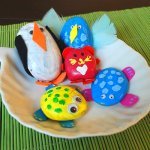10 Tips on Reading to Baby

In the first few months of life, an infant's brain organizes itself based on the child's language experiences. If a child is not exposed to quality language, these connections become harder and harder to make as the child grows older. The TYPE of language that children hear is also important. If adults are talking amongst each other or merely giving the infant brief and irrelevant language exchanges, then language development is unlikely to flourish. Reading to infants can be an easy task, if you know just what to do.
1.Get cozy. Snuggle on a sofa, on the floor, in a rocking chair...wherever you and baby are comfy.
2.Choose books carefully. These tips for choosing preschool books can be applied to books for babies too!
3.Choose books that babies can manipulate safely - board books and books made of cloth or vinyl are baby-friendly.
4.Read with expression. No one, not even a baby, wants to hear a monotone! For example, when you read Baby Faces make faces that mirror the words "yucky" and "uh-oh." Change the tone of your voice to match the text and/or illustrations.
5.Pause in-between pages and give Baby time to look at the images.
6.Point to and describe pictures in the book.
7.Pay attention to your baby's cues.If a baby is looking at a page for a while, don't be so quick to turn the page. Let him/her take it all in. On the other hand, if a baby shows no interest in a particular book, don't push it. Try another book or activity.
8.Keep books where babies can reach them. If you keep all of your baby's books out of reach, how will they ever "tell" you that they want to read? How will you know which books are your baby's favorites? How will they learn to make choices based on their own preferences?
9.Re-read often. Babies learn from repetition, so it is OK, even preferred, if you read a few favorites over and over again!
10.Read every day.






